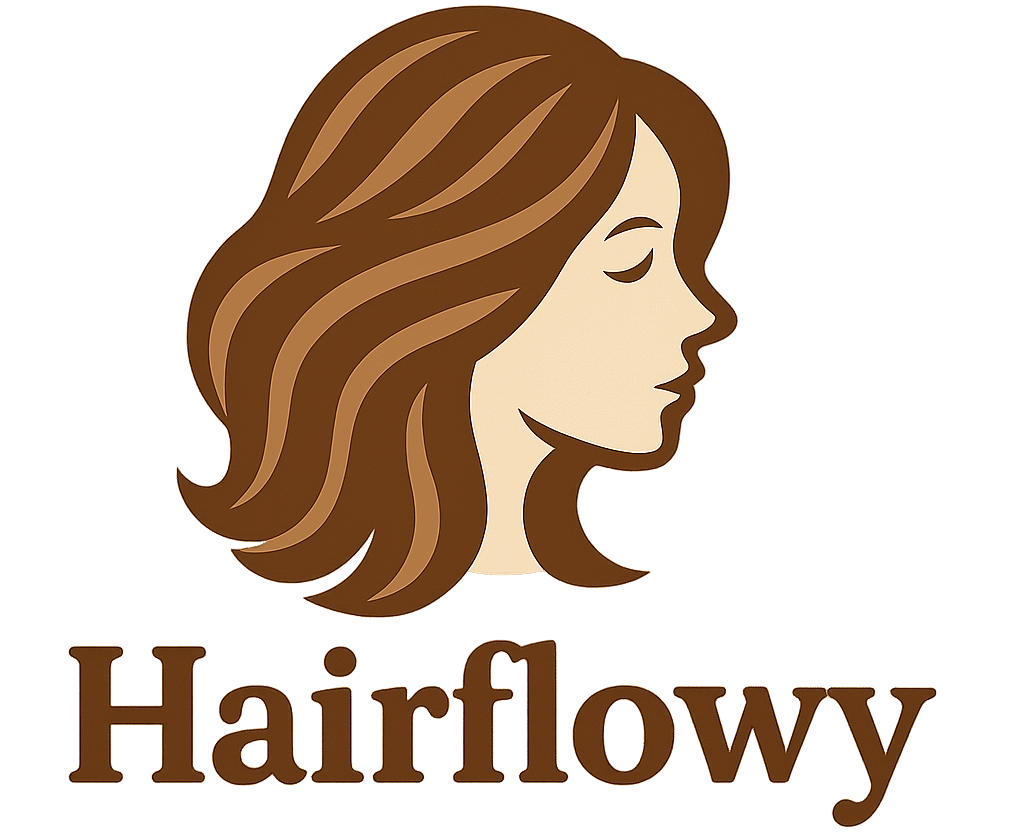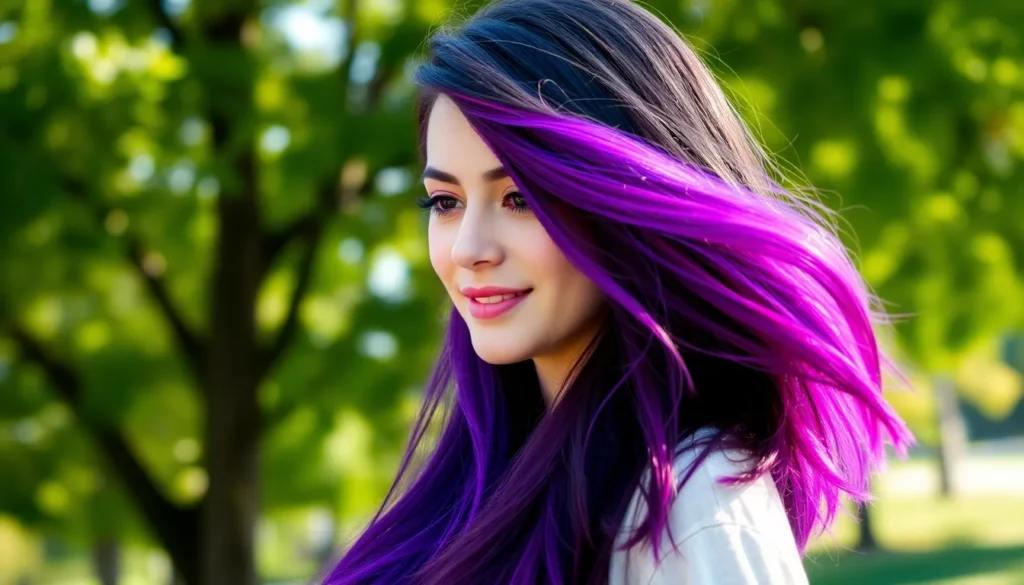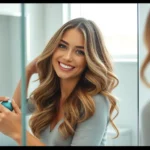We’ve all been there – staring in the mirror wondering how to add some excitement to our hair without making a dramatic change. Under hair coloring has become the perfect solution for those of us who want to experiment with bold colors while maintaining a professional or natural appearance on top.
This hidden gem technique allows us to express our creativity by adding vibrant hues underneath our natural hair color. Whether we’re dreaming of electric blues peeking through when we move or subtle pastels that catch the light we can achieve stunning results that are both versatile and low-maintenance.
The beauty of under hair color lies in its flexibility – we can go as bold or as subtle as we want. From rainbow streaks to single accent colors the possibilities are endless. We’ll explore the most popular color combinations professional techniques and maintenance tips to help you achieve the perfect hidden masterpiece that reflects your unique style.
Peek-a-Boo Rainbow: Hidden Multicolor Strands
Rainbow under hair creates a stunning surprise element that transforms your style with every movement. We’ve perfected this technique to help you achieve maximum color impact while keeping your professional appearance intact.
Layered Rainbow Placement Techniques
Strategic placement makes rainbow under hair coloring truly spectacular and ensures each color gets proper visibility. We recommend starting with the bottom layer closest to your neck and working upward in distinct sections.
Bottom layer rainbow placement works best when we section hair horizontally about 2 inches from the hairline. Create four equal segments within this bottom section for red, orange, yellow, and green colors. Each segment should measure approximately 1 inch wide to maintain color definition.
Middle layer positioning requires lifting the next 2 inch section and dividing it into three parts for blue, indigo, and violet shades. We space these colors strategically so they peek through when you move your head or style your hair in different ways.
Staggered rainbow application involves alternating color placement between layers to create depth and dimension. Place complementary colors like red and green in different layers to prevent muddy mixing. We’ve found this technique creates the most ever-changing visual effect when hair moves naturally.
Sectioning tools make precise rainbow placement achievable at home or in professional settings. Use tail combs to create clean horizontal parts and hair clips to separate each colored section. We recommend numbering each section with temporary markers to track your color sequence.
Color Blending for Seamless Transitions
Smooth color transitions prevent harsh lines and create professional looking rainbow under hair results. We achieve seamless blending through exact application techniques that merge colors naturally.
Feathering technique involves applying color with gentle brushing motions where two rainbow shades meet. Blend the edges of each color section using a clean brush to soften transitions. We typically feather about 1/4 inch of each color boundary to create natural looking gradients.
Color bridging uses intermediate shades between primary rainbow colors to create smoother transitions. Apply yellow between red and green sections, or use purple between red and blue areas. We’ve discovered this technique eliminates harsh color breaks that can look unnatural.
Overlapping application creates depth by slightly extending each rainbow color into adjacent sections. Paint each color about 1/8 inch beyond its designated boundary before blending. We find this overlap technique prevents gaps between colors that might show your natural hair color.
Processing time coordination ensures all rainbow colors develop evenly for consistent results. Start with colors requiring longer processing times like blue and purple, then add faster developing shades like yellow and orange. We recommend staggering application by 5 to 10 minute intervals based on your exact color products.
Electric Blue Underlayers: Bold Ocean-Inspired Hues
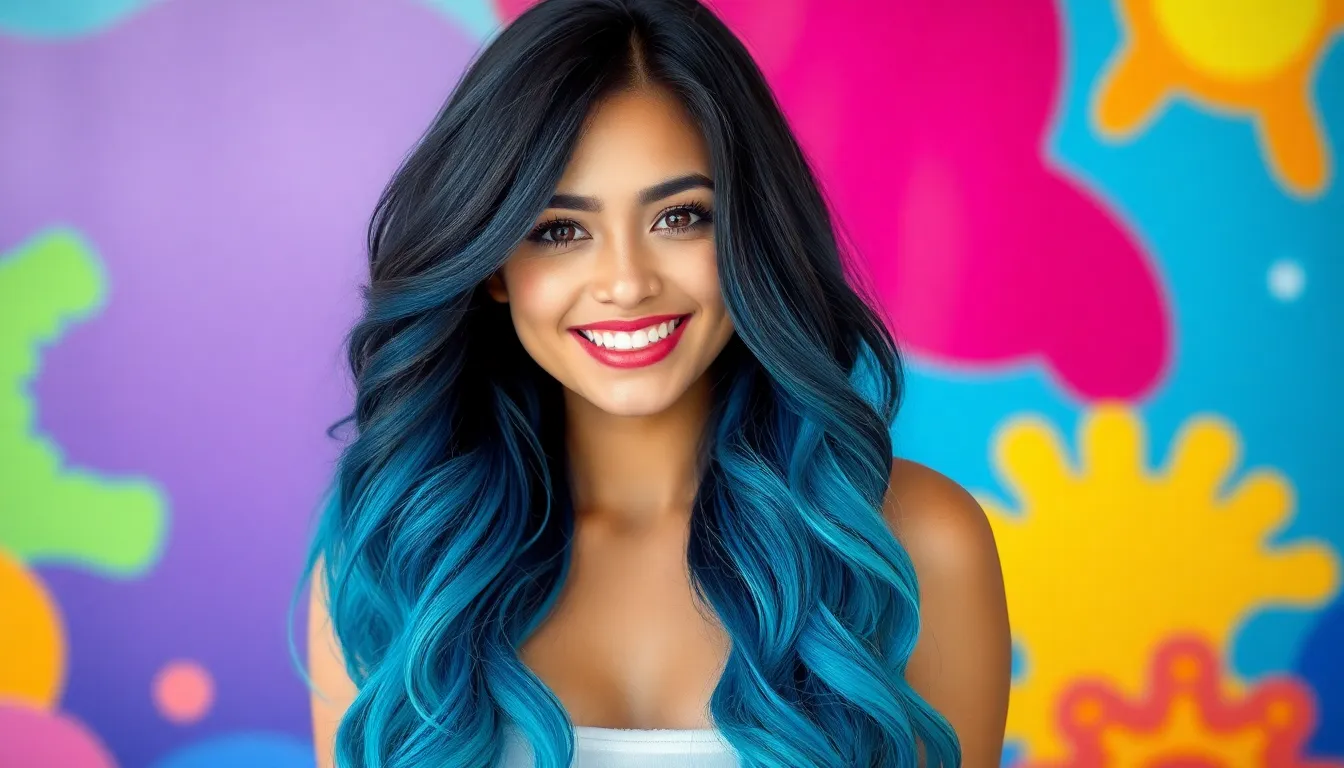
Electric blue underlayers create a vibrant underwater fantasy that transforms your hair into an oceanic masterpiece. We’ve seen this bold color choice become increasingly popular among those seeking dramatic yet sophisticated hidden color options.
Navy to Turquoise Gradient Options
Gradient techniques offer stunning visual depth when transitioning from navy blue roots to turquoise tips. We recommend starting with deep navy at the roots and gradually lightening to create that perfect oceanic ombre effect. Professional colorists achieve this look by sectioning the under layer into horizontal bands, applying darker pigments at the base and progressively lighter shades toward the ends.
Oceanic Ombre represents the ultimate in gradient sophistication, blending deep sea blue with bright turquoise to mirror natural ocean depths. We’ve found this technique works exceptionally well on medium to long hair lengths where the gradient has space to develop properly. Stylists typically use three to four different blue tones to create seamless transitions that mimic how ocean colors shift from surface to depth.
Layered application ensures each section receives proper saturation while maintaining smooth color transitions. We suggest dividing the under layer into quarter inch sections for precise color placement and optimal blending results.
Maintenance Tips for Blue Pigments
Regular conditioning becomes essential for preserving vibrant blue tones and preventing premature fading. We recommend using moisturizing shampoos specifically formulated for color treated hair to maintain both health and pigment integrity.
Color protecting products extend the life of blue underlayers significantly when used consistently. We’ve observed that sulfate free formulas work best for maintaining electric blue and turquoise shades. Professional grade color sealers can lock in pigments for up to six weeks longer than standard products.
Heat styling poses the greatest threat to blue pigment longevity, causing rapid color degradation. We advise minimizing blow dryer use and applying heat protectant sprays when styling is necessary. Cold water rinses help seal the hair cuticle and preserve color vibrancy between salon visits.
Scheduled touch ups every four to six weeks prevent visible regrowth lines and maintain color consistency. We suggest booking maintenance appointments before important fading occurs to ensure seamless color correction and optimal results.
Purple Power: Lavender to Plum Hidden Highlights
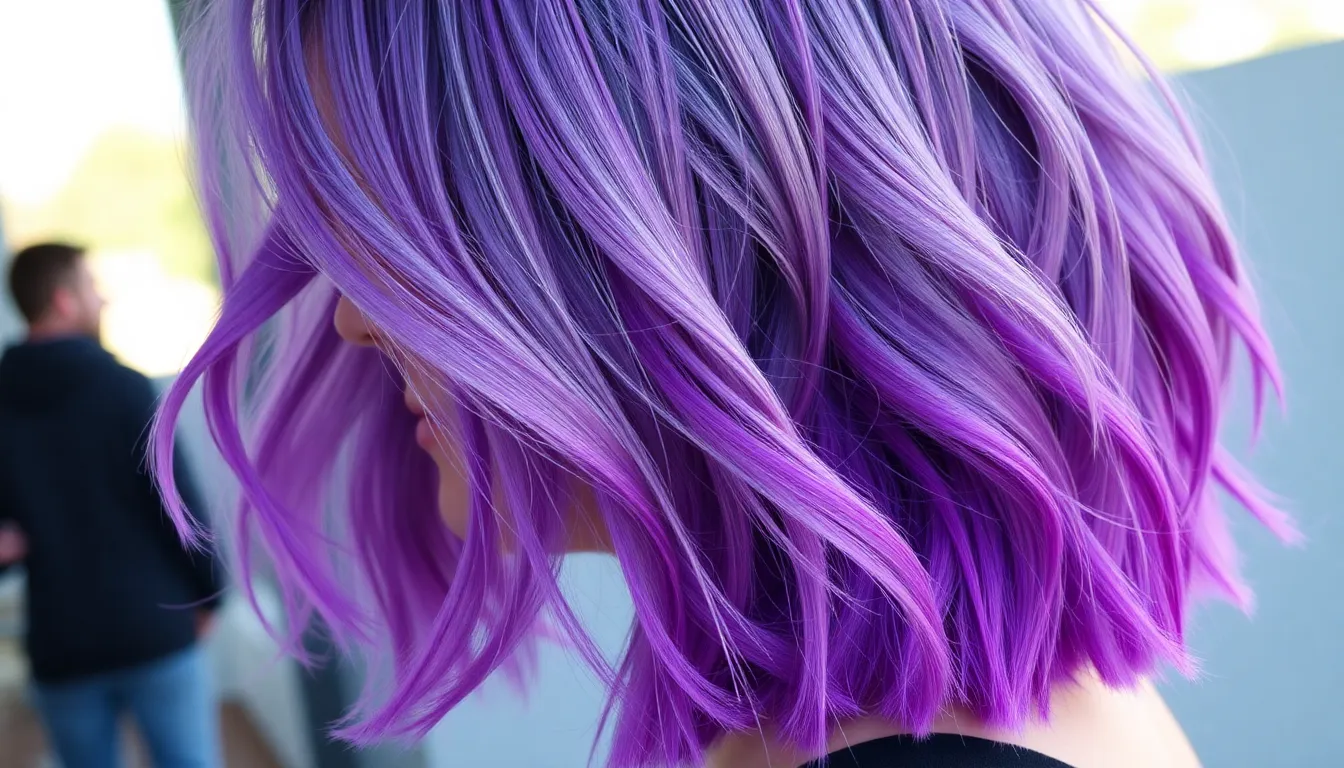
Purple hidden highlights offer endless possibilities for creating stunning under hair color transformations. These versatile shades range from soft pastels to rich berry tones, allowing you to express your creativity while maintaining professional flexibility.
Cool-Toned Purple Variations
Lavender highlights create the perfect soft, pastel foundation for your hidden color journey. We recommend placing these delicate purple tones underneath your top hair layers to achieve that coveted “peek-a-boo” effect that adds surprise and dimension to any hairstyle.
Electric purple delivers maximum impact when you’re ready to make a bold statement. This vibrant cool-toned option pairs exceptionally well with dark bases like black or dark brown hair, creating stunning contrast that catches light beautifully.
Blue-based purples provide softer alternatives to their red-based counterparts while maintaining sophisticated appeal. These hues work particularly well with lighter hair colors, offering interesting contrast without overwhelming your natural base tone.
Warm-Toned Purple Alternatives
Plum highlights bring rich, berry-like warmth to your hidden color palette. These deeper purple tones complement darker hair colors such as brown or auburn perfectly, creating luxurious depth that enhances your natural beauty.
Raspberry-plum combinations offer multi-dimensional possibilities when you want something truly unique. Mixing these warm berry tones creates complex color stories that add warmth to your overall palette while maintaining purple’s mystical appeal.
Grape-inspired tones bridge the gap between warm and cool purple families with their balanced undertones. These versatile shades work beautifully for both warm and cool skin tones, making them ideal choices for those unsure about their perfect purple match.
Hidden purple highlights work best when placed strategically underneath your hair’s top layers, allowing for subtle contrast without fully committing to bold looks. This placement technique makes purple under hair color suitable for both casual weekend adventures and professional workplace environments.
Fire Engine Red: Statement-Making Crimson Underneath
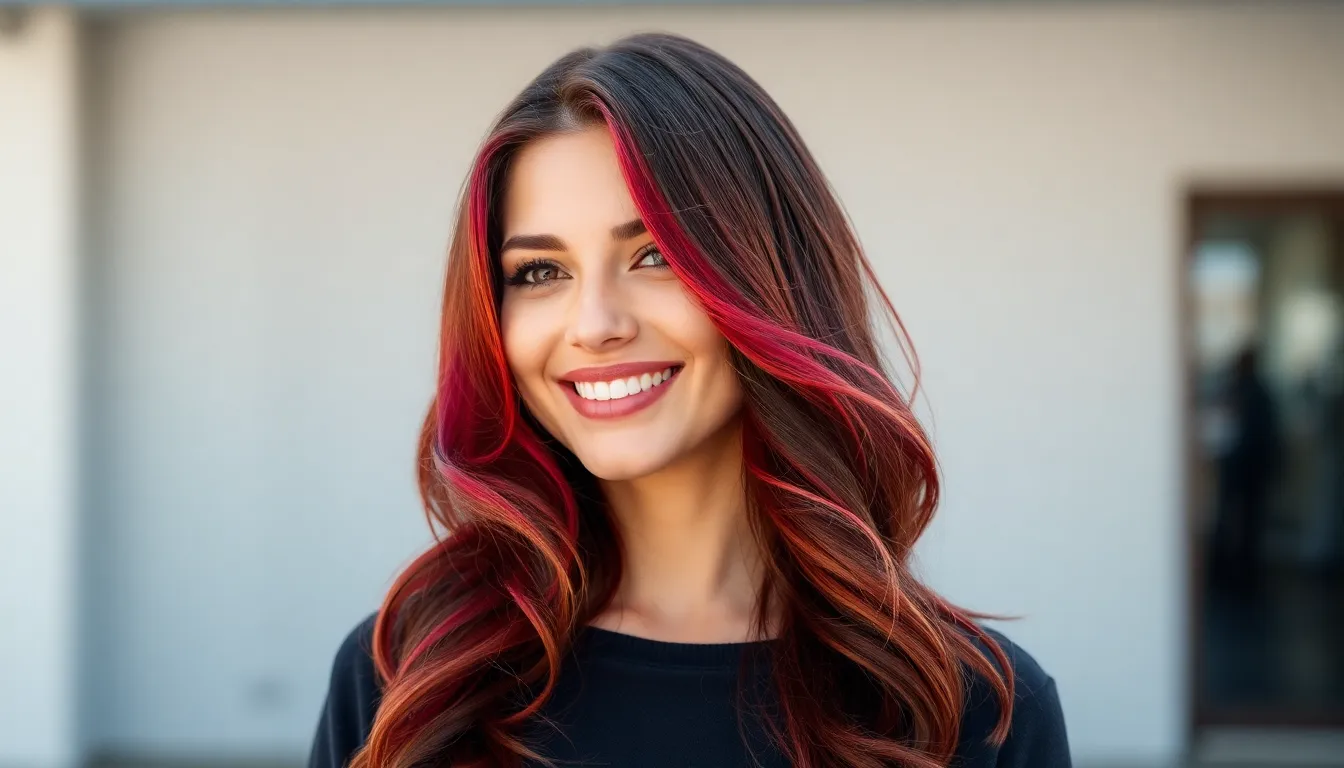
Fire engine red creates one of the most dramatic under hair color transformations we’ve seen in modern hair styling. This vibrant crimson shade delivers maximum impact when hidden beneath your natural hair color, offering the perfect balance between bold expression and professional versatility.
Cherry Red vs. Deep Burgundy Choices
Cherry red brings a lighter, more playful energy to your underlayer with its bright and vibrant appearance. We recommend this shade for those seeking a fun pop of color that catches attention without overwhelming your overall look. The lighter intensity makes cherry red perfect for first-time under hair color experiments.
Deep burgundy offers sophisticated richness that adds depth and elegance to your hidden color palette. This darker red tone creates subtle dimension when revealed, making it ideal for professional environments where you want understated drama. We’ve found that deep burgundy works exceptionally well with brunette base colors, creating seamless transitions between visible and hidden sections.
| Red Shade Comparison | Vibrancy Level | Best For | Professional Setting |
|---|---|---|---|
| Cherry Red | High | Playful looks | Moderate |
| Deep Burgundy | Medium | Sophisticated styles | High |
Skin Tone Compatibility Considerations
Cool skin tones naturally complement fire engine red shades due to their blue undertones. We suggest pairing cool complexions with cherry red options that enhance your natural coloring without creating harsh contrasts. Pink undertones in cool skin work beautifully with vibrant red hues.
Warm skin tones benefit from deeper burgundy choices that harmonize with golden and peachy undertones. These earthy complexions can handle rich, wine-inspired reds that add warmth without clashing with natural coloring. We’ve observed that warm skin tones particularly shine with burgundy red combinations.
Neutral skin tones enjoy the flexibility to experiment with both cherry red and deep burgundy options. This versatile complexion type allows for bold color choices without worrying about undertone conflicts. We recommend testing both shades to determine which red intensity best matches your personal style preferences.
Sunset Vibes: Orange and Yellow Hidden Layers
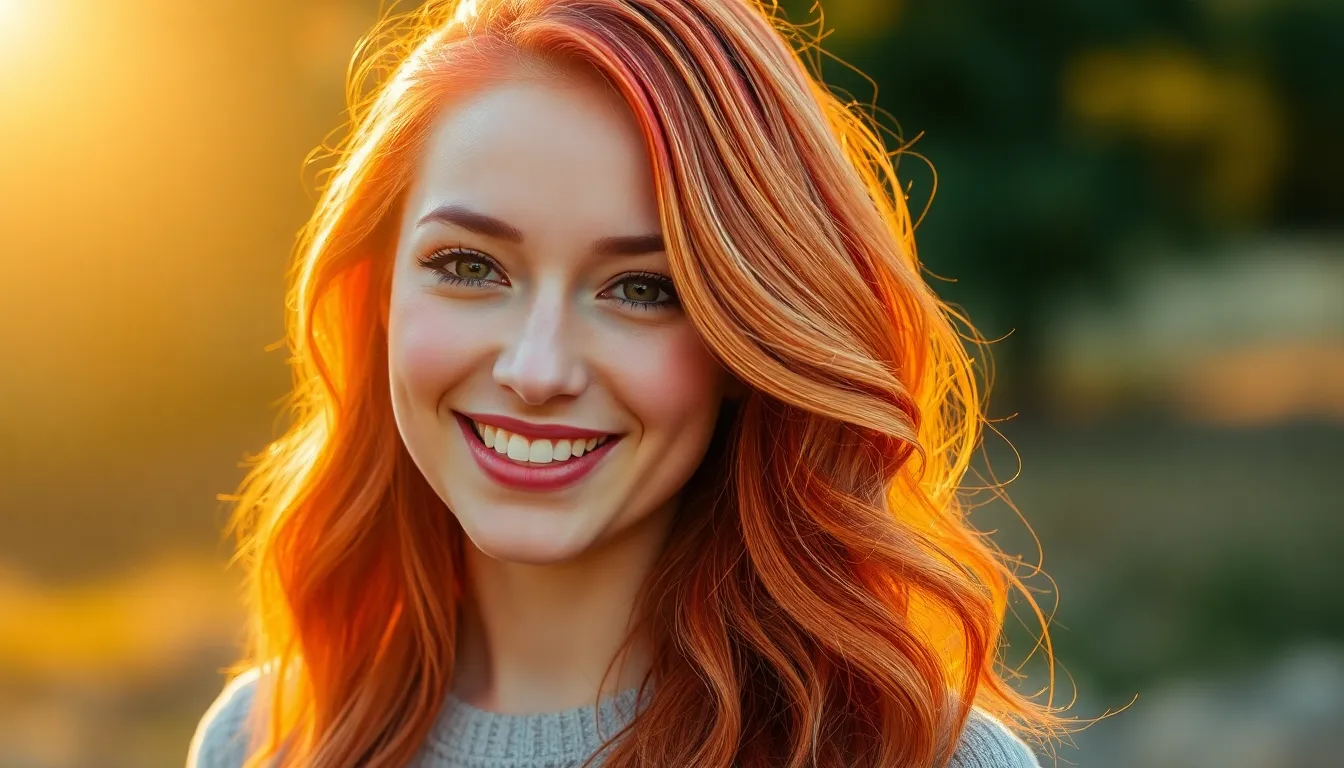
Channeling the warm glow of golden hour, sunset inspired under hair colors blend orange and yellow tones to create a stunning multi dimensional effect. We’ll explore how these warm hues work together to produce one of the most sought after hidden layer color combinations.
Peachy Coral Undertones
Peachy coral hair combines pink, orange, and rose gold undertones to create versatile warmth beneath your natural color. Cool skin tones benefit from emphasized pink undertones, while warm complexions shine with more orange based elements in the mix.
Skin Tone Compatibility:
| Skin Tone | Recommended Undertones | Effect |
|---|---|---|
| Cool | Pink emphasized | Balanced contrast |
| Warm | Orange emphasized | Natural warmth |
| Neutral | Mixed pink/orange | Customizable depth |
Pairing peachy coral with blonde bases creates striking contrast, whereas brunette foundations provide rich depth to the coral tones. Semi permanent options like Crazy Color’s Peachy Coral deliver vibrant results for temporary transformation, while Splat’s Peachy Coral offers another accessible choice for experimenting with this trendy shade.
Strategic placement works best when coral tones occupy the lower third of your hair, allowing natural movement to reveal these sunset inspired hues. Layering different intensities of peach and coral creates dimension that mimics natural sun kissed effects throughout the hidden sections.
Golden Yellow Accent Placement
Golden yellow accents enhance the overall sunset theme by adding bright, sun like highlights to complement orange and coral tones. Accentuating hair ends with golden yellow creates the most natural sun kissed appearance, as this placement mimics where sunlight would naturally lighten hair.
Strategic Placement Options:
- End focused: Apply golden tones to bottom 2-3 inches for maximum impact
- Streak placement: Position thin golden streaks throughout hidden layers for subtle dimension
- Highlighting technique: Use golden yellow as primary highlight color for overall warmth
Thin streaks of golden yellow distributed throughout hidden sections provide subtle yet impactful contrast against deeper sunset tones. This placement technique ensures color visibility during natural hair movement while maintaining professional appearance when hair lies flat.
Balayage application works exceptionally well for golden accents, allowing for natural looking color graduation that blends seamlessly with orange and coral elements. Processing times should coordinate across all sunset tones to ensure even color development and prevent patchy results in the final look.
Cotton Candy Dreams: Soft Pink Concealed Colors
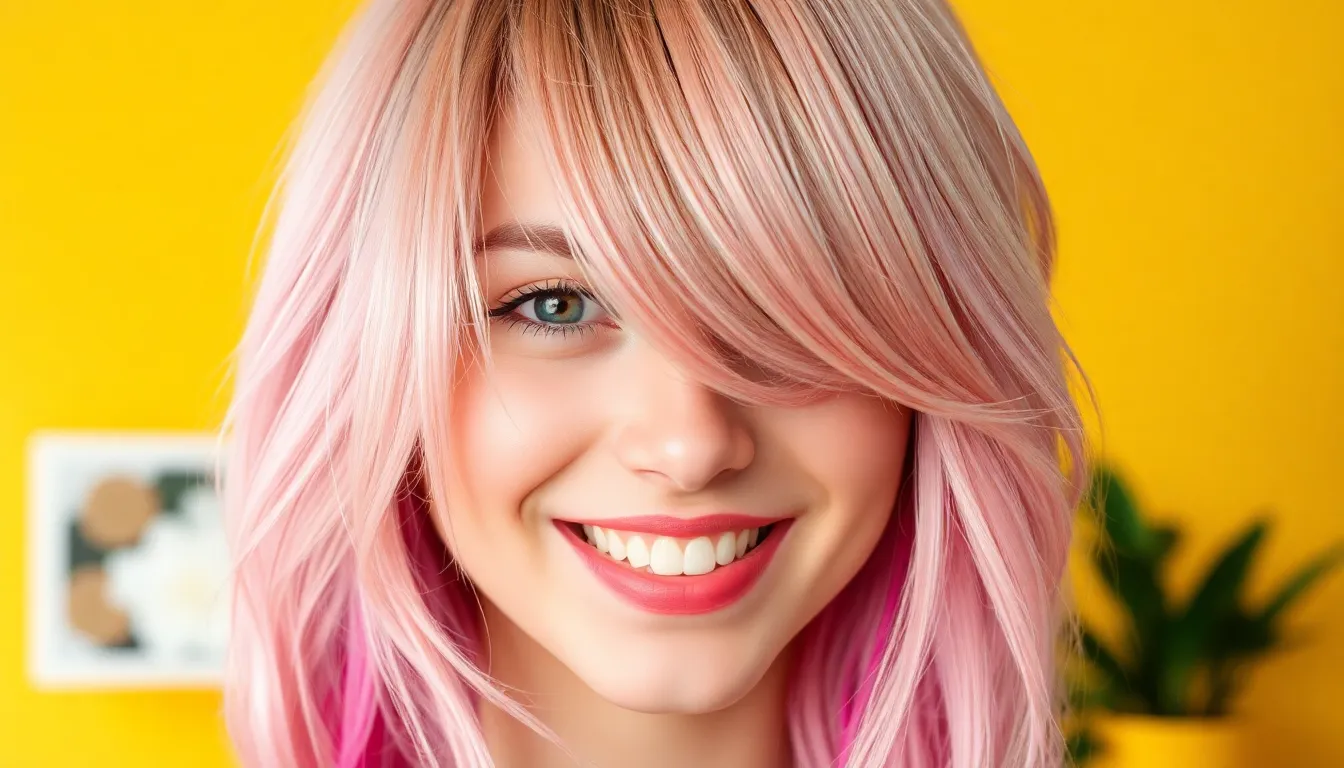
Creating a cotton candy inspired soft pink look involves layering pastel shades beneath your natural hair color for a whimsical, dreamy effect. We recommend starting with lightened hair at level 9 to ensure optimal color uptake when using semi-permanent dyes like Manic Panic Cotton Candy Pink.
Rose Gold Hidden Highlights
Rose gold offers a sophisticated metallic finish that complements both warm and cool skin tones beautifully. We suggest using L’Oréal Paris Colorista Hair Makeup Temporary 1-Day Hair Color Spray in Rose Gold for those wanting to test this trendy shade before committing to a permanent change.
Semi-permanent rose gold applications work exceptionally well when placed strategically underneath your main hair color. Position these highlights in the lower sections of your hair where they’ll catch light naturally and create stunning dimension. The metallic undertones in rose gold blend seamlessly with cotton candy pink, creating a multi-tonal effect that shifts between soft pink and warm copper tones.
For maximum impact, we recommend sectioning horizontal layers and applying rose gold to alternating sections beneath your top layer. This technique allows the color to peek through naturally as you move, creating that coveted hidden highlight effect that’s both professional and playful.
Bubble Gum Pink Placement Strategies
Bubble gum pink delivers a more vibrant punch than cotton candy shades while still maintaining that sweet, nostalgic appeal. Split color techniques work particularly well with this bold shade, where we apply bubble gum pink to one side of your head and leave the other side natural or pair it with a complementary color.
Layered placement creates the most versatile results for bubble gum pink applications. We position the pink on top layers with deeper tones underneath, or reverse this approach by placing the bright pink beneath natural colored top sections. This layered effect allows you to control how much color shows in different settings and styling arrangements.
Strategic sectioning in the nape area works beautifully for those seeking maximum concealment during professional settings. Apply bubble gum pink to the lowest third of your hair, focusing on areas that naturally fall beneath your ears. When your hair is down, the color remains completely hidden, but updos and ponytails reveal stunning pops of vibrant pink that transform your entire look.
Forest Fantasy: Green Undertones for Nature Lovers
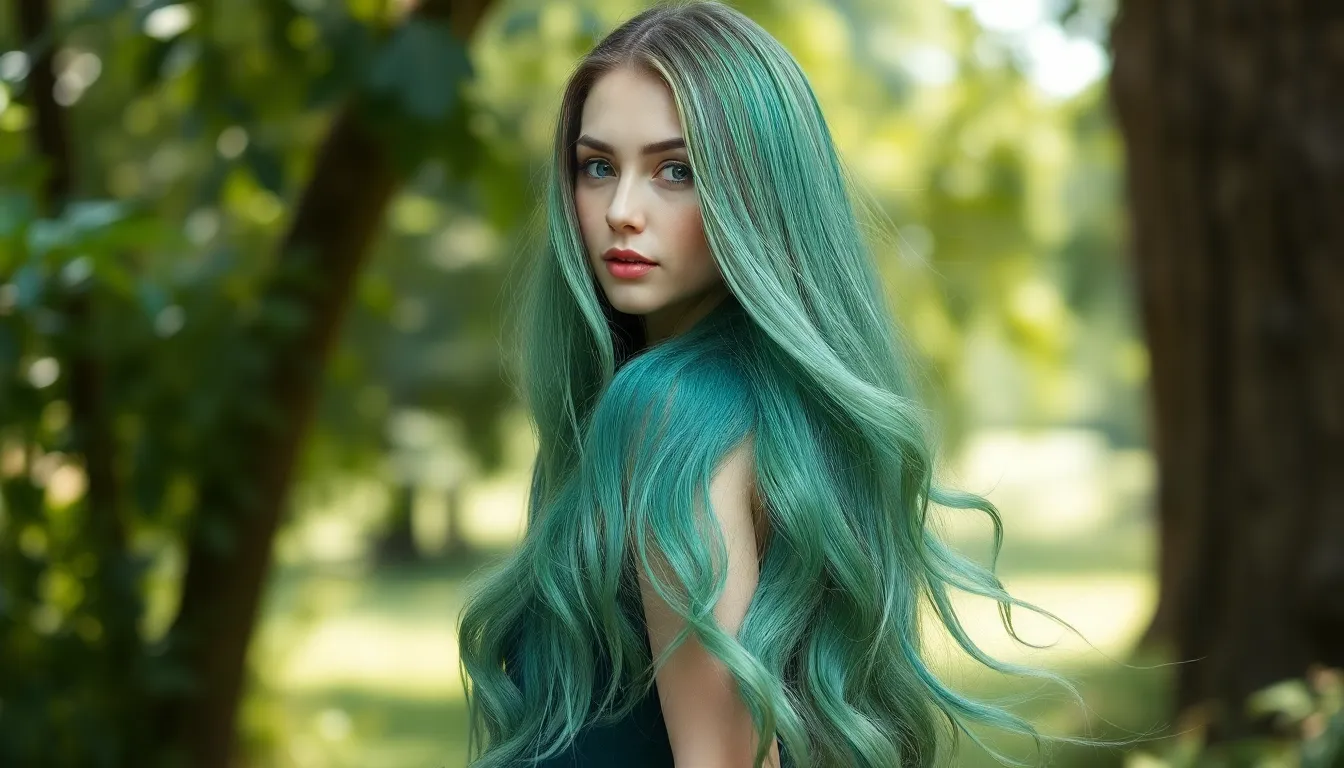
Green undertones bring the tranquil beauty of nature to your hidden hair color, offering a sophisticated departure from brighter rainbow options. These earthy tones work exceptionally well for those seeking a more subdued yet striking under hair transformation.
Emerald and Sage Color Combinations
Emerald green creates a vibrant foundation that pairs beautifully with softer sage tones for a multi dimensional forest effect. We recommend placing emerald at the roots transitioning to sage at the tips to mimic natural foliage patterns. This combination works particularly well for medium to dark skin tones, as the warmth of sage balances the coolness of emerald perfectly.
Layering these two shades requires careful sectioning to ensure both colors remain visible when hair moves naturally. Professional colorists often apply emerald to the lower sections first, then weave sage highlights throughout for depth and dimension. The contrast between bold emerald and muted sage creates visual interest without overwhelming your natural hair color above.
Strategic placement of this color duo works best when concentrated in the nape area and side sections. This positioning allows the green tones to peek through during updos while remaining completely hidden in professional settings. Touch ups every six to eight weeks help maintain the vibrancy of both emerald and sage tones.
Mint Green Subtle Accents
Mint green offers the perfect entry point for those hesitant about bold green undertones, providing a soft pastel alternative that’s both playful and professional. This delicate shade requires hair to be lightened to level nine or higher to achieve true color clarity and prevent muddy results. We find mint green particularly stunning on lighter skin tones where the cool undertones create a harmonious complement.
Balayage techniques work exceptionally well with mint green, allowing for natural looking placement that mimics sun kissed highlights. The soft nature of mint means it can be applied more liberally than bolder greens without creating an overwhelming effect. Combining mint with ash blonde or silver tones creates a whimsical, ethereal look that’s perfect for creative professionals.
Maintenance for mint green requires gentle, sulfate free products to preserve the delicate pigment. We recommend using color depositing conditioners weekly to refresh the mint tones between salon visits. This shade typically fades gracefully to a soft silvery tone, making grow out less noticeable than with more vibrant green options.
Monochrome Magic: Black and White Contrast Colors
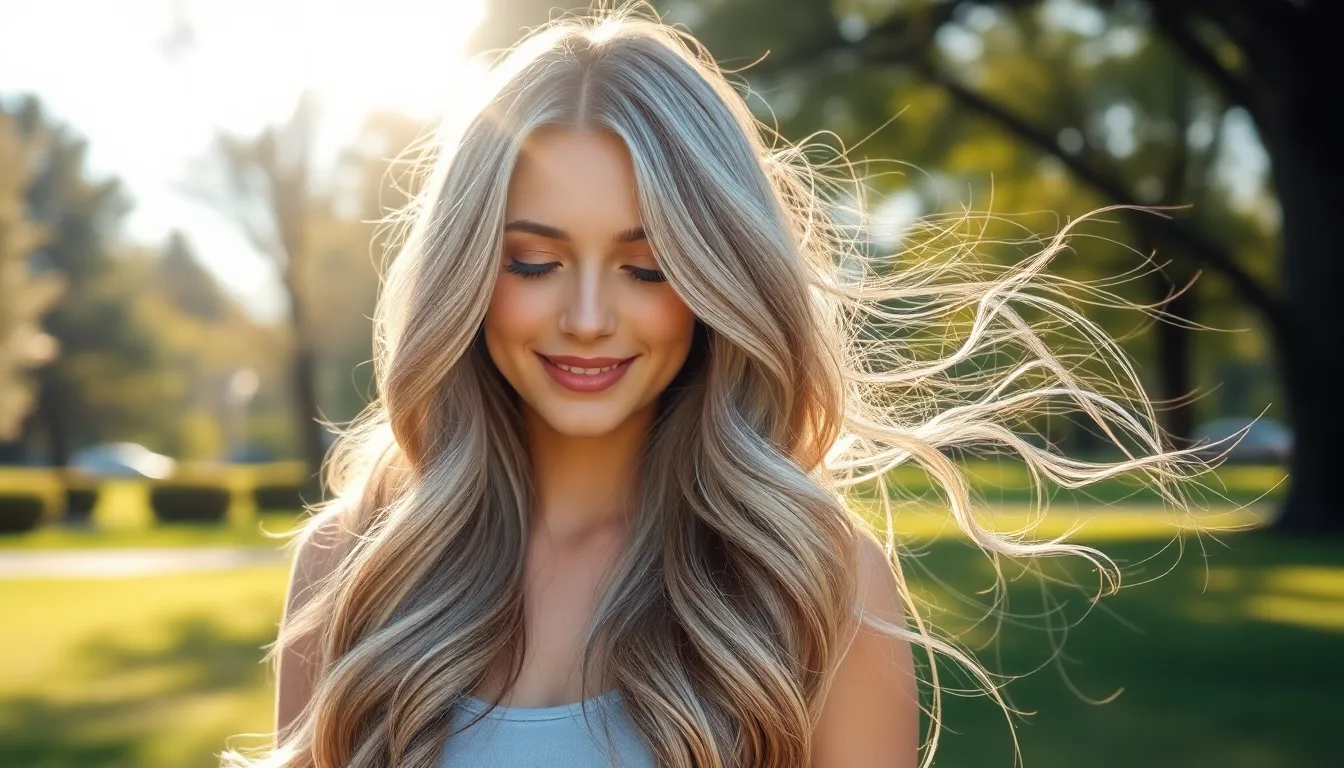
Black and white under hair combinations create the most dramatic contrast possible in hair coloring. These timeless color combinations offer sophisticated elegance while maintaining maximum impact beneath your natural hair color.
Silver and Platinum Hidden Streaks
Silver and platinum hidden streaks add sophisticated shimmer to any base color while remaining completely professional when styled down. We recommend using a balayage technique to apply these metallic tones strategically throughout the underlayers of your hair.
Application involves sectioning the lower third of your hair and applying silver or platinum color in vertical strips approximately one inch apart. This spacing ensures the streaks peek through naturally when you move your hair or style it in updos.
Color processing for silver and platinum requires pre-lightening dark hair to level 9 or 10 for optimal results. These metallic tones show best on properly lightened hair and can appear muddy on darker bases.
Maintenance for these light colors involves using purple toning shampoo weekly to prevent yellowing. Silver and platinum streaks typically need touch ups every 6 to 8 weeks to maintain their brilliant shine and prevent visible regrowth lines.
Jet Black Dramatic Underlayers
Jet black dramatic underlayers create depth and dimension by adding the darkest possible contrast beneath lighter top sections. This technique works exceptionally well for creating volume illusions and adding mysterious drama to your overall look.
Strategic placement involves dyeing the bottom two thirds of your hair jet black while keeping your natural color on top. We suggest leaving approximately 2 to 3 inches of your natural color visible when hair is worn down for maximum contrast effect.
Color formulation for jet black requires a permanent dye with blue or violet undertones to prevent fading to brown. Professional colorists often mix level 1 black with small amounts of blue pigment to achieve the deepest possible black shade.
Styling benefits include enhanced hair movement visibility and the ability to create striking updos that reveal the dramatic black sections. Jet black underlayers also make lighter top colors appear more vibrant by providing the ultimate contrast backdrop.
Long term wear makes this option ideal for those wanting dramatic change without full commitment since the black remains hidden during professional settings but emerges beautifully in casual styles.
Maintenance Must-Knows: Caring for Your Hidden Hair Colors
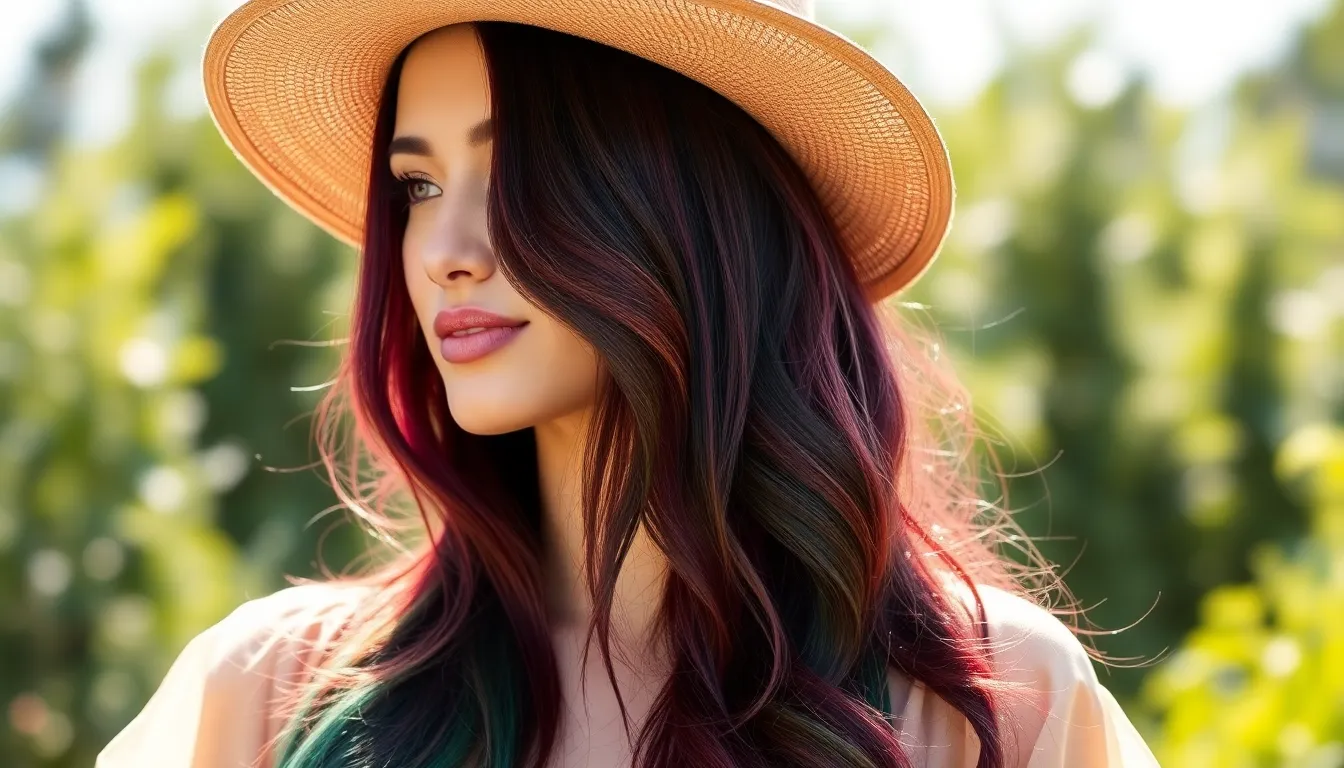
Protecting your vibrant under hair colors requires exact care techniques to maximize color longevity. We’ll guide you through essential maintenance strategies that keep your hidden hues looking fresh and vibrant.
Color-Safe Product Recommendations
Sulfate-free shampoos and conditioners form the foundation of color preservation. These gentle formulas maintain moisture while protecting color vibrancy from harsh chemicals that strip pigments.
Color depositing conditioners like oVertone help maintain unnatural hair colors between salon visits. We recommend applying these treatments weekly to refresh fading tones and extend color life.
Color-safe hair masks should become part of your routine once or twice weekly. These intensive treatments maintain both color integrity and moisture balance in processed hair.
UV-protective shampoos and conditioners shield your hidden colors from sun damage. Combine these products with physical protection like hats or hoods when spending extended time outdoors.
Heat protector products create a barrier against styling tool damage. Always apply these before using hot tools to prevent color fade and maintain hair health.
| Product Type | Frequency | Primary Benefit |
|---|---|---|
| Sulfate-free shampoo | Every 2-3 days | Color preservation |
| Color depositing conditioner | Weekly | Color refresh |
| Color-safe hair mask | 1-2 times weekly | Moisture and color maintenance |
| UV protection products | Daily | Sun damage prevention |
Touch-Up Scheduling Guidelines
Schedule regular touch-ups based on your exact color’s fading pattern. Most vivid under hair colors require professional refreshing every 4-6 weeks to maintain optimal vibrancy.
Choose colors that fade gracefully into your natural shade to reduce maintenance frequency. Colors like deep burgundy or forest green typically require less frequent touch-ups than electric blues or hot pinks.
Monitor your color’s fade pattern during the first few weeks after application. This observation helps establish your personal touch-up timeline and prevents visible regrowth lines.
Book appointments in advance with your colorist to maintain consistent color quality. Regular scheduling ensures availability and helps track your color’s performance over time.
Consider seasonal adjustments to your touch-up schedule. Summer sun exposure and winter dryness can affect fade rates, requiring modified maintenance timing.
Professional vs. DIY: Choosing Your Coloring Method
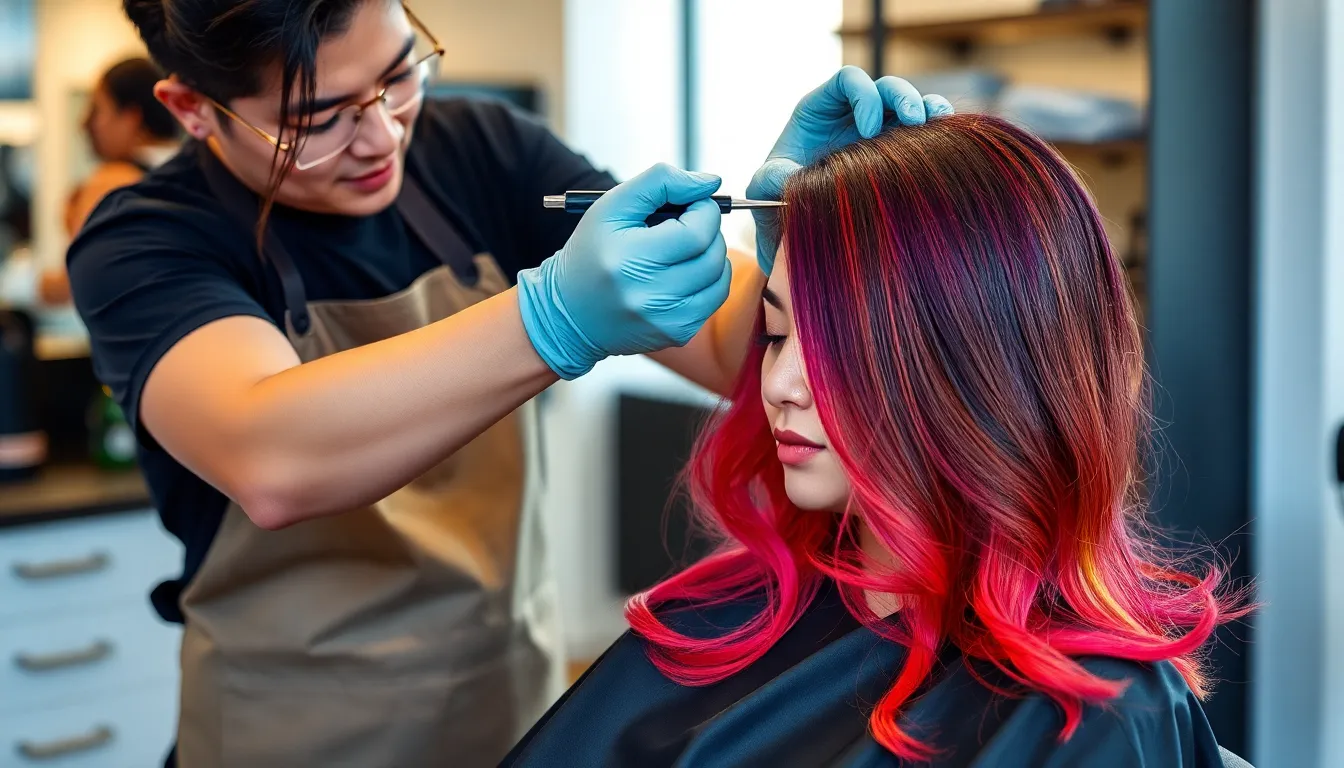
Deciding between professional salon services and at-home coloring kits requires careful consideration of your under hair color goals and experience level.
Salon Consultation Benefits
Professional stylists assess your hair type, texture, and previous color history to recommend the best dye and technique for your exact needs. Expertise transforms complex under hair color visions into reality, with colorists mixing custom formulas to achieve exact shades that complement your skin tone and lifestyle.
Quality makes a important difference in both results and hair health, as salons use professional-grade dyes that minimize damage while providing long-lasting vibrancy. Efficiency becomes apparent when professionals complete intricate under hair designs in fewer sessions compared to multiple DIY attempts.
Personalized advice extends beyond color selection to include maintenance schedules, styling tips, and future color transition planning. Complex techniques like rainbow layering or gradient effects require professional expertise to ensure even processing times and seamless color blending.
At-Home Application Safety Tips
Follow instructions provided with your dye kit carefully, as each brand has exact timing and application requirements for optimal results. Performing a patch test 48 hours before application prevents allergic reactions and ensures your skin tolerates the formula safely.
Protective gear prevents unnecessary stains and chemical contact, so always wear gloves and cover clothing with old towels or capes. Research proper sectioning techniques before starting, as strategic hair division ensures even coverage and prevents patchy results in your under hair color.
Work in well-ventilated areas to avoid inhaling chemical fumes, and have a friend assist with hard-to-reach sections for complete coverage. Apply petroleum jelly around your hairline to prevent skin staining, and keep cotton swabs handy for immediate cleanup of any mistakes.
Processing time accuracy determines your final color intensity, so set multiple timers and check sections regularly to avoid over-processing. Rinse thoroughly with cool water until it runs clear, then apply the included conditioner to seal the hair cuticle and lock in your new under hair color.
Styling Secrets: Showcasing Your Under Hair Colors
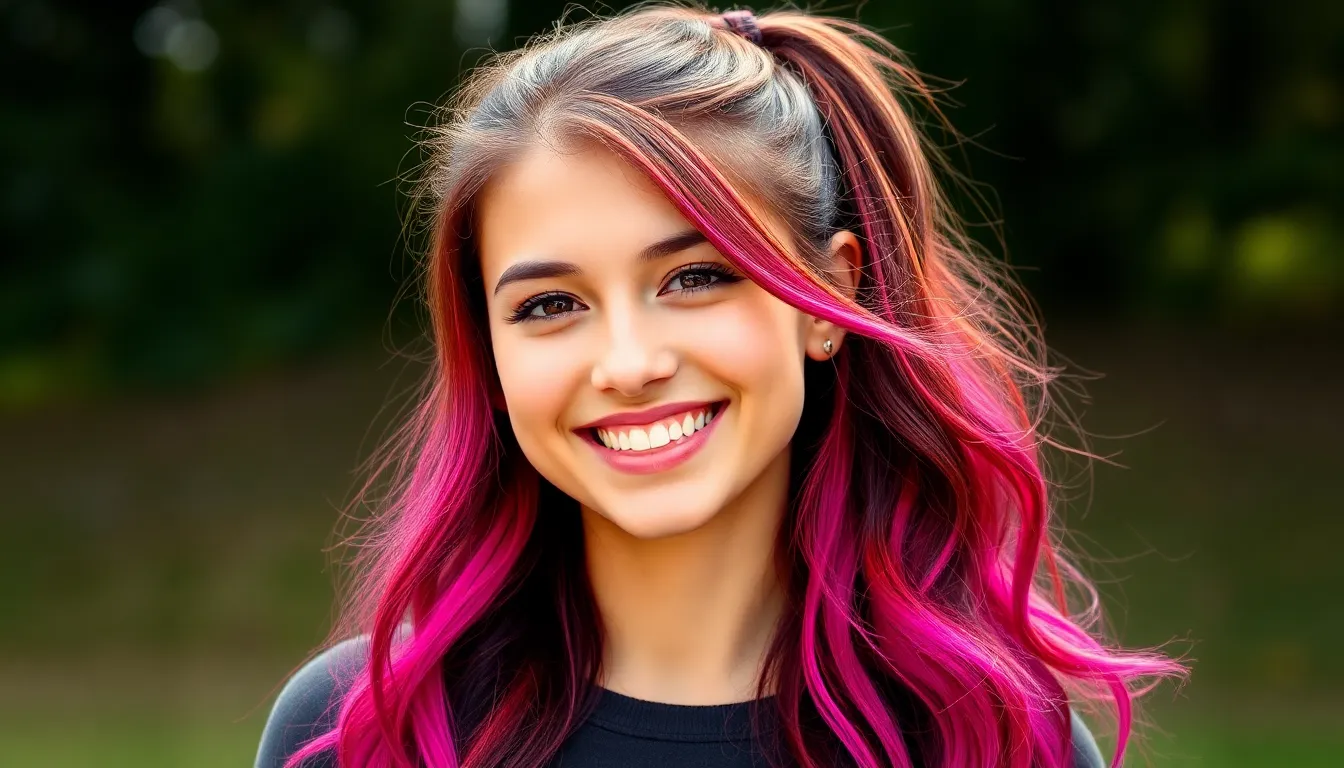
Strategic styling transforms hidden color investments into stunning visual statements. We’ll explore exact techniques that reveal your vibrant under layers while maintaining versatility for any occasion.
Braiding Techniques for Color Reveal
Reverse braids expose colored sections by flipping traditional braiding patterns inside out. Start with a standard three-strand braid at your nape and deliberately pull the outer strands over the center section instead of under. This technique brings the underneath layers to the surface while creating an intricate textural element.
Inside out French braids showcase under colors through deliberate strand manipulation. Begin sectioning hair at your crown and braid backwards toward your nape, crossing sections over rather than under the center strand. The reversed pattern naturally exposes your hidden hues throughout the entire braid length.
Dutch braids with strategic loosening reveal pops of color through controlled texture. Create standard Dutch braids but gently tug at the outer edges of each section after completing the braid. This pancaking technique expands the braid width and allows glimpses of your under colors to peek through the loosened sections.
Side swept braids position color reveals along your most visible angles. Sweep all hair to one side and create a loose side braid that naturally exposes the colored underneath layers. The asymmetrical placement draws attention to your hidden hues while maintaining an effortless, romantic aesthetic.
Half-Up Styles for Maximum Impact
Half up ponytails create immediate color contrast by lifting your top layer. Gather hair from your temples to your crown and secure with an elastic band, leaving the bottom half to showcase your vibrant under colors. The clean division between natural and colored sections creates striking visual impact.
Half up pigtails double the color exposure through symmetrical styling. Part your hair down the center and create two high ponytails using only the top sections of hair. The dual placement allows both sides of your under colors to frame your face while maintaining a playful, youthful vibe.
Twisted half up styles add textural interest while revealing hidden hues. Twist small sections from each temple back toward your crown and secure with bobby pins or a small elastic. The twisted texture creates movement that naturally separates your top and bottom layers, highlighting the color contrast.
Half up space buns maximize color visibility through elevated placement. Create two small buns using only your top layer hair, positioning them high on your crown. The dramatically lifted sections expose maximum under layer coverage while creating an edgy, festival ready aesthetic.
Braided half up crowns frame your face while showcasing color depth. Braid small sections along your hairline from ear to ear, securing at the back of your head. This crown like placement lifts your top layer while allowing your colored underneath sections to cascade freely around your shoulders.
Conclusion
Under hair coloring opens up a industry of creative possibilities that perfectly balance personal expression with professional flexibility. We’ve explored everything from vibrant rainbow effects to sophisticated monochrome contrasts, each offering unique ways to showcase your personality while maintaining versatility in your daily look.
Whether you choose the dramatic appeal of fire engine red or the subtle elegance of rose gold highlights, proper maintenance and strategic styling will ensure your hidden colors remain vibrant and impactful. Remember that professional consultation can make all the difference in achieving your vision safely and effectively.
The beauty of under hair coloring lies in its adaptability – it’s your secret pop of color that reveals itself when you want it to. With the right techniques and care routine, you’ll have endless opportunities to surprise and delight while keeping your options open for any occasion.
Frequently Asked Questions
What is under hair coloring?
Under hair coloring is a technique where vibrant colors are applied to the lower layers of hair while keeping the natural color on top. This allows you to experiment with bold colors like rainbow streaks, electric blue, or purple highlights while maintaining a professional appearance. The colored sections remain hidden under your natural hair but can be revealed through specific styling techniques.
How long does under hair color last?
Under hair color typically lasts 4-6 weeks before requiring touch-ups, depending on the type of dye used and your hair care routine. Semi-permanent dyes fade faster than permanent ones. To extend color longevity, use sulfate-free shampoos, color-protecting products, minimize heat styling, and apply UV protection. Regular maintenance with color-depositing conditioners can help refresh fading tones between salon visits.
Can I do under hair coloring at home?
Yes, you can do under hair coloring at home using DIY kits, but professional salon services are recommended for complex color combinations and optimal results. If choosing DIY, ensure proper sectioning, use protective gear, follow processing times accurately, and perform strand tests first. Professional stylists offer expertise in color placement, blending techniques, and personalized advice for your hair type.
What colors work best for under hair coloring?
Popular under hair colors include electric blue, purple highlights, fire engine red, sunset orange-yellow blends, soft pink, emerald green, and monochrome black-white contrasts. Color choice depends on your skin tone, lifestyle, and desired effect. Cool skin tones pair well with vibrant blues and purples, while warm tones suit deeper burgundy and coral shades. Neutral skin tones can experiment with most color options.
How do I style my hair to show the under color?
To showcase under hair colors, try reverse braids, inside-out French braids, half-up hairstyles, or high ponytails. These techniques expose the colored lower layers while maintaining versatility. Strategic sectioning during coloring ensures maximum visibility when styled. Updos and braided styles work particularly well for revealing hidden colors, transforming your look from professional to creative with simple styling changes.
Will under hair coloring damage my natural hair?
Under hair coloring involves bleaching and dyeing processes that can cause some damage, but proper technique and aftercare minimize risks. Professional application reduces damage through expert sectioning and quality products. Maintain hair health with moisturizing treatments, sulfate-free products, and regular deep conditioning. The technique affects only lower layers, leaving most of your natural hair untouched and healthy.
How much does professional under hair coloring cost?
Professional under hair coloring costs vary widely based on location, salon reputation, color complexity, and hair length. Simple single-color applications typically cost less than complex rainbow or gradient effects. Consultation fees, bleaching requirements, and follow-up treatments affect pricing. Many salons offer package deals for initial coloring plus maintenance visits. Contact local salons for specific pricing in your area.
What’s the best way to maintain under hair color vibrancy?
Maintain under hair color vibrancy by using sulfate-free shampoos and conditioners, applying color-depositing treatments weekly, and using color-safe hair masks. Protect from UV damage with hair sunscreen, minimize heat styling, and use heat protectants when necessary. Schedule touch-ups every 4-6 weeks, avoid chlorinated water, and sleep on silk pillowcases to reduce color fading and maintain moisture.
